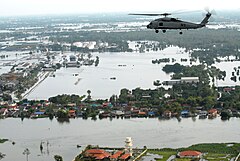
Back فيضانات تايلاند 2011 Arabic Паводка ў Тайландзе (2011) Byelorussian Oversvømmelsen i Asien 2011 Danish Überschwemmungen in Thailand 2011 German Inundaciones de Tailandia de 2011 Spanish 2011ko Thailandiako uholdeak Basque Inondations de 2011 en Thaïlande French Banjir Thailand 2011 ID タイ洪水 (2011年) Japanese 2011년 태국 홍수 Korean
This article needs additional citations for verification. (October 2021) |
 A United States Navy helicopter observes flooded areas in the outskirts of Bangkok. | |
| Date | 25 July 2011 – 16 January 2012 (175 days)[1] |
|---|---|
| Location | 65 of Thailand's 77 provinces[1] |
| Deaths | 815[1] |
| Property damage | 1.425 trillion baht (USD46.5 billion)[2] |
Severe flooding occurred during the 2011 monsoon season in Thailand. The flooding began at the end of July triggered by the landfall of Tropical Storm Nock-ten. These floods soon spread through the provinces of northern, northeastern, and central Thailand along the Mekong and Chao Phraya river basins. In October floodwaters reached the mouth of the Chao Phraya and inundated parts of the capital city of Bangkok. Flooding persisted in some areas until mid-January 2012, and resulted in a total of 815 deaths (with three missing) and 13.6 million people affected. Sixty-five of Thailand's 76 provinces were declared flood disaster zones, and over 20,000 square kilometres (7,700 sq mi) of farmland was damaged.[1] The disaster was described by an unnamed Thai government official as "the worst flooding yet in terms of the amount of water and [number of] people affected".[3]
The World Bank has estimated 1,425 trillion baht (US$46.5 billion) in economic damages and losses due to flooding, as of 1 December 2011.[2][4][5] Most of this was due to the manufacturing industry, as seven major industrial estates were inundated in water as much as 3 meters (9.8 feet) deep during the floods.[6] Disruptions to manufacturing supply chains affected regional automobile production and caused a global shortage of hard disk drives which lasted throughout 2012.
The World Bank's estimate for this disaster means it ranks as the world's fourth costliest disaster as of 2011 surpassed only by the 2011 Tōhoku earthquake and tsunami in Japan, Great Hanshin earthquake in 1995, and Hurricane Katrina in 2005.[7] A 2015 study suggests increasing odds for potential flooding similar to the 2011 flood intensity to occur in the future.[8]
Thailand's southern provinces also saw seasonal flash-flooding towards the end of the year, although these were not as destructive as the floods in the more northerly provinces.
- ^ a b c d "รายงานสรุปสถานการณ์ อุทกภัย วาตภัย และดินโคลนถล่ม ฉบับที่ 129 วันที่ 17 มกราคม 2555" [Summary report of floods, storms and mudslides, issue 129, dated 17 January 2012.] (PDF) (in Thai). 24/7 Emergency Operation Center for Flood, Storm and Landslide. 17 January 2012. Retrieved 25 January 2012.[permanent dead link]
- ^ a b "The World Bank Supports Thailand's Post-Floods Recovery Effort". World Bank. 13 December 2011. Archived from the original on 1 December 2012. Retrieved 25 January 2012.
- ^ Cite error: The named reference
AFP 3 Octwas invoked but never defined (see the help page). - ^ Haraguchi, Masahiko; Lall, Upmanu (December 2015). "Flood risks and impacts: A case study of Thailand's floods in 2011 and research questions for supply chain decision making" (PDF). International Journal of Disaster Risk Reduction. 14 (3): 256–272. Bibcode:2015IJDRR..14..256H. doi:10.1016/j.ijdrr.2014.09.005. ISSN 2212-4209. Archived (PDF) from the original on 9 June 2015. Retrieved 6 October 2016 – via Columbia University.
- ^ Tang, Alisa (2 December 2011). "Thailand cleans up; Areas remain flooded". Time. Associated Press. Archived from the original on 8 January 2012. Retrieved 2 December 2011.
- ^ Mydans, Seth (21 October 2011). "Bangkok Opens Floodgates as Government Response Is Criticized". The New York Times. Archived from the original on 5 June 2020.
- ^ Zhang, Bo (30 March 2011). "Top 5 most expensive natural disasters in history". Archived from the original on 6 April 2019. Retrieved 2 December 2011.
- ^ Promchote, Parichart; Wang, S.-Y. Simon; Johnson, Paul G. (January 2016). "The 2011 Great Flood in Thailand: Climate Diagnostics and Implications from Climate Change". Journal of Climate. 29 (1): 367–379. Bibcode:2016JCli...29..367P. doi:10.1175/JCLI-D-15-0310.1. JSTOR 26385277. Archived from the original on 20 July 2018 – via Utah State University.